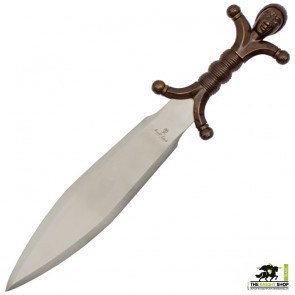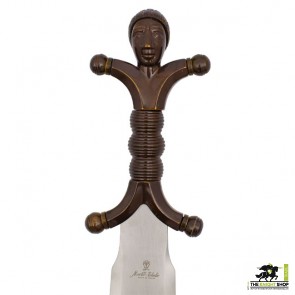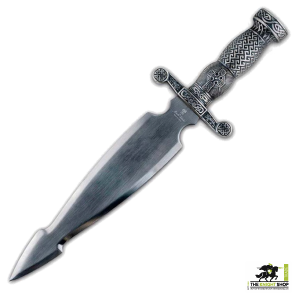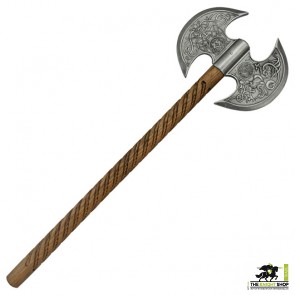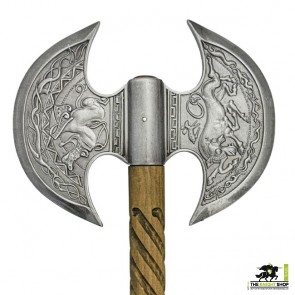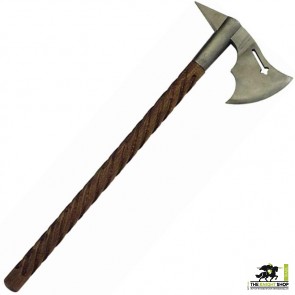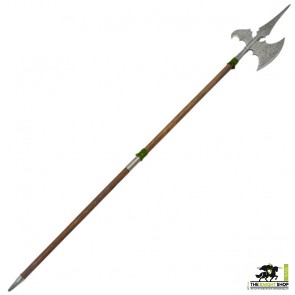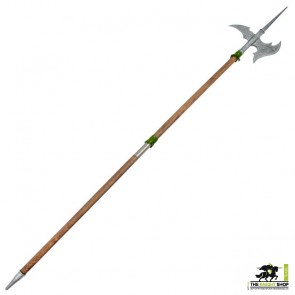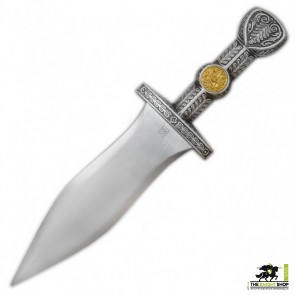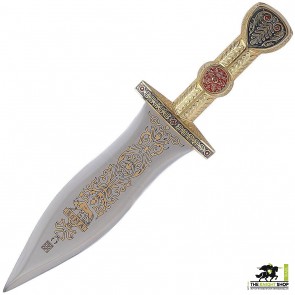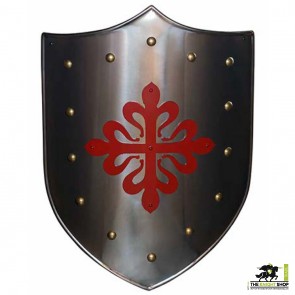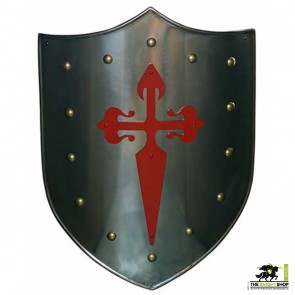Weaponry
The Knight Shop Trade are the largest wholesalers of replica historical weaponry for sale in the UK. Our diverse range caters for Reenactors, Historical European Martial Artists (HEMA), Live Action Role Players (LARP), Collectors, Stage Fighters (Theatre) and T.V. producers.
We wholesale an incredible range of replica weaponry from throughout history for trade. From the Classical Period we offer a range of Celtic, Greek and Roman weaponry such as Roman Pugio Daggers, Pilums and Scutum shields. From the later Dark Age period we have a great selection of Saxon seaxes and Viking battle axes
We wholesale a fantastic variety of display and useable re-enactment quality Medieval weaponry - everything a Knight would need to get ready for battle! Our range of daggers, polearms, maces, warhammers and axes will not disappoint! For the Renaissance era Pirate or Highwayman we have a great selection of flintlock pistols to choose from.
-
North Grimston Celtic Dagger
The North Grimston Dagger was found by accident in 1902 while laborers were digging on Lord Middleton´s land near North Grimston. The smaller of the two swords discovered was decorated with an anthropomorphic (man-shaped) handle. Ownership of such a rare item marks the man buried at North Grimston out to be one of the most important people of Iron Age East Yorkshire.
Learn More
The dagger is one of a small number of similar weapons found across Celtic Europe which features a human figure forming the hilt. Other examples were found in Hungary, Northern Italy, Switzerland, and France. This dagger can now be seen on display at Hull and East Riding Museum.
Overall Length: 43cm
Blade: AISI 420 Stainless Steel
Weight: 500g
Edge: Blunt
Scabbard: None
All dimensions are approximate and may vary from piece to piece. -
Celtic Dagger
The Celtic people lived during the Iron Age, dominating most of western and central Europe. They decorated their weapons handles with precious stones, ivory, or enamel. They adorned the swords and helmets with original human figures or animal heads. The weapons were almost sacred to the ancient Celts. One for the battlefield, more sober and functional, and another ceremonial, much more elaborate.
Learn More
Overall Length: 36cm
Blade: Tempered Stainless Steel
Weight: 400g
Edge: Blunt
All dimensions are approximate and may vary from piece to piece. -
Viking Ceremonial Axe
Perhaps the most common hand weapon among Vikings was the axe. This beautiful axe has a solid-wood shaft, decorated with a spiral pattern, while the axe-blade has a double-head and is embellished with ornately decorative designs. Simple in its form but highly decorated, this axe is the ideal collector's piece that shows off both the axes simplistic shape, as well as beautiful eye-catching features.
Learn More
Length: 60cm
All dimensions are approximate and may vary from piece to piece. -
Medieval War Axe
Our War Axe by Marto is a reproduction of a 15th century axe used by mounted knights, very effective against light armored opponents. The handle is made in wood, the head is made in steel, composed of a frontal axe and a rear spike, good for piercing armors.
Learn More
Length: 60cm
All dimensions are approximate and may vary from piece to piece.
Buy the Medieval War Axe with confidence from the UK’s leading Medieval Axe retailer. -
Medieval Swiss Halberd
The two-handed Halberd or Pike has been a staple in medieval warfare for years. The combined functions of an axe and a spear make this a formidable piece of battle hardware. This 14th - 15th Century Swiss Halberd, by Marto, is a replica of the Pike design used by the early Swiss armies to repel military attacks and proved its effectiveness in defeating the enemy.
Learn More
The handle of this Halberd is made of wood and is adorned with two fringed fabric plumes. The head is made of cast metal and consists of three features. A frontal axe-head with a single curved edge, a rear hooked talon, and a central fluted spike. The cast metal head displays a highly decorative engraved floral design as this item is meant for display purposes, not for use.
Length: 205cm
All dimensions are approximate and may vary from piece to piece.
Buy the Halberd with confidence from the UK’s leading medieval weaponry retailer. -
Medieval Spanish Pike
The Halberd or Pike has been a staple in medieval warfare for years. The combined functions of an axe and a spear make this a formidable piece of battle hardware.
Learn More
This 16th Century Spanish Pike by Marto is a replica of the Pike design used in the feared Spanish military formation known as the "Tercio". This military formation gained notoriety thanks to its incredible effectiveness in defeating the enemy.
The handle of this Pike is made of wood and is adorned with a fringed fabric plume. The head is made of cast metal and consists of three features. A frontal axe-head with a double-curved edge, a rear talon, and a central straight spike.
The cast metal head displays a highly decorative engraved floral design as this item is meant for display purposes, not for use.
Length: 205cm
All dimensions are approximate and may vary from piece to piece.
Buy the Halberd with confidence from the UK’s leading medieval weaponry retailer. -
Roman Dagger - Silver
The Romans are known to have borrowed ideas on the weapons of their enemies. Initially, they used weapons of Etruscan and Greek-style or, when confronted with the Celts, adopted their equipment. To defeat the Carthaginians built a fleet based on the Carthaginian model. Once a weapon is adopted it was standard. The weapons changed over the history of Rome, although its equipment and its use were never individual. Almost all Roman swords and daggers were double-edged and could be used for both cutting and threading.
Learn More
The pugio was a small dagger used by the ancient Roman soldiers possibly as an auxiliary weapon. Like other equipment of the Legionnaires, the dagger had a series of changes throughout the I century. Generally had a long blade and leaf-shaped, between 18 and 28 centimeters long and 5 centimeters or more across. It was ideal for threading; a good rush can pierce a chainmail weapon.
Total length: 38cm
Weight: 900g
Blade: Stainless Steel
Edge: Blunt
Scabbard: None
All dimensions are approximate and may vary from piece to piece. -
Roman Dagger - Gold
The Romans are known to have borrowed ideas on the weapons of their enemies. Initially, they used weapons of Etruscan and Greek-style or, when confronted with the Celts, adopted their equipment. To defeat the Carthaginians built a fleet based on the Carthaginian model. Once a weapon is adopted it was standard. The weapons changed over the history of Rome, although its equipment and its use were never individual. Almost all Roman swords and daggers were double-edged and could be used for both cutting and threading.
Learn More
The pugio was a small dagger used by the ancient Roman soldiers possibly as an auxiliary weapon. Like other equipment of the Legionnaires, the dagger had a series of changes throughout the I century. Generally had a long blade and leaf-shaped, between 18 and 28 centimeters long and 5 centimeters or more across. It was ideal for threading; a good rush can pierce a chainmail weapon.
Total length: 38cm
Weight: 900g
Blade: Stainless Steel
Edge: Blunt
Scabbard: None
All dimensions are approximate and may vary from piece to piece. -
Red Calatrava Cross Shield
Exquisitely handcrafted in stainless steel with a polished finish. At the shields heart is a red Cross. The emblem of the order of the Calatrava. The Order of Calatrava was one of the four Spanish military orders and the first military order founded in Castile, but the second to receive papal approval. The papal bull confirming the Order of Calatrava as a Militia was given by Pope Alexander III on September 26, 1164. It was said that even when outnumbered more than ten to one, the Knights of the Calatrava were still victorious. The Calatrava Cross had truly protected them. It is believed that he who harnessed the power of the Four Triads represented by the Calatrava Cross would find success in all areas of life.
Learn More
The triangular shield, known as a kite shield, is double reinforced steel with triple reinforced corners. Beautifully embellished detailing of riveted Golden fittings frame a natural steel finish and adds to the stunning contrast which makes this shield so stunning.
Comes with an attached hanging chain on the back which allows for easy wall mounting.
Height: 63cm
Width: 43cm
Weight: 3.2kg
All dimensions are approximate and may vary from piece to piece. -
Red St. James Cross Shield
Exquisitely handcrafted in stainless steel with a polished. This finish is a truly intriguing piece of memorabilia. At the shields heart is a red Santiaguist or Santiago Cross. The Order of Santiago also known as "The Order of St. James of the Sword," was founded in the 12th century, and owes its name to the Patron Saint of Spain. In heraldry, the Cross of Saint James also called the Santiago cross or the Cruz espada, is a charge in the form of a cross.
Learn More
The red sword-cross known as the "Cross of St James" is represented as a red cross Flory or flowered cross over a white field, where the shape of the cross is actually the blade of a sword. The military red cross of St James of Compostela is one of Galicia's oldest national symbols and can often be found in Galician heraldry and iconography.
The triangular shield, known as a kite shield, is double reinforced steel with triple reinforced corners. Beautifully embellished detailing of riveted golden studding and red emblem against a natural steel finish adds to the stunning contrast which makes this shield so exquisite.
Comes with an attached hanging chain on the back which allows for easy wall mounting.
Height: 63cm
Width: 43cm
Weight: 3.2kg
All dimensions are approximate and may vary from piece to piece.




